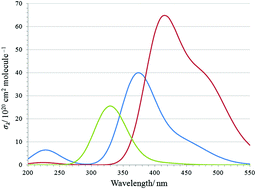Kinetics of the BrO + HO2 reaction over the temperature range T = 246–314 K
Abstract
The kinetics of the reaction between gas phase BrO and HO2 radicals, BrO + HO2 → HOBr + O2 (1), have been studied over the atmospherically relevant temperature range T = 246–314 K and at ambient pressure, p = 760 ± 20 Torr, using laser flash photolysis coupled with ultraviolet absorption spectroscopy. The reaction was initiated by the generation of bromine monoxide radicals following laser photolytic generation of Br atoms from Br2/Cl2 containing mixtures and their reaction with ozone. Subsequently, the addition of methanol vapour to the reaction mixture, in the presence of excess oxygen, afforded the efficient simultaneous post-photolysis formation of HO2 radicals using well-defined chemistry. The decay of BrO radicals, in the presence and absence of HO2, was interrogated to determine the rate coefficients for the BrO + BrO and the BrO + HO2 reactions. A detailed sensitivity analysis was performed to ensure that the BrO + HO2 reaction was unequivocally monitored. The rate coefficient for reaction (1) is described by the Arrhenius expression:  where statistical errors are 1σ. The negative temperature dependence of this reaction is in general accord with those reported by previous studies of this reaction. However, the present work reports greater absolute values for k1 than those of several previous studies. An assessment of previous laboratory studies of k1 is presented. This work confirms that reaction (1) plays a significant role in HOBr formation throughout the atmosphere following both anthropogenic, biogenic and volcanic emissions of brominated species. Reaction (1) therefore contributes to an efficient ozone depleting process in the atmosphere, and further confirms the significance of interactions between two different families of reactive atmospheric trace species.
where statistical errors are 1σ. The negative temperature dependence of this reaction is in general accord with those reported by previous studies of this reaction. However, the present work reports greater absolute values for k1 than those of several previous studies. An assessment of previous laboratory studies of k1 is presented. This work confirms that reaction (1) plays a significant role in HOBr formation throughout the atmosphere following both anthropogenic, biogenic and volcanic emissions of brominated species. Reaction (1) therefore contributes to an efficient ozone depleting process in the atmosphere, and further confirms the significance of interactions between two different families of reactive atmospheric trace species.



 Please wait while we load your content...
Please wait while we load your content...